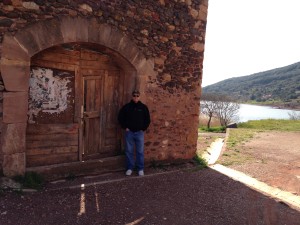Ghost towns fascinate us. The notion of a place, sinking into decrepitude but still clearly recognizable as a town or city, produces a sort of magnetic force upon tourists and others with a little extra time on their schedule.
Which explains as well as anything how it was we happened to go out of our way to visit what is left of the little town of Celles in the mountains about 15 miles north of where we are living, in France’s Languedoc region.
Celles, the ghost town, is not particularly well known, nor is it promoted by the local tourism board, and I likely would never have come to see if were I not searching for a road that came closest to Lac du Salagou.
The map had these words: “Celles: Vage ruine” (village ruins), at the end of a road that appeared to run right down to the water.
And there it was, south of Lodeve, west of Clermont L’Herault, falling to pieces, a former farming town now on the edge of the man-made lake and a bit eerie, as all ghost towns are.
It is a simple but almost silly story of the French government not getting things quite right, and it is laid out in more detail in the Google-translated French-language wiki page.
In short, the French government decided it wanted to dam some streams to create a lake up in the mountainous area just north and above the rolling hills of the Pezenas area, which is closer to the Mediterranean Sea.
It would create a lake out of what had been stream beds, drowning square miles of land with the trapped water — which then could be used for agriculture or water sports.
Calculations by engineers suggested the new lake would rise just high enough to drown the town of Celles, and everyone was ordered to leave, during the 1960s.
About 80 people were dislocated, leaving behind their stone homes and outbuildings.
However, when the new lake was finished filling, from 1965 to 1970, it was found that the water had not drowned Celles — it only lapped at the edge of the town, which would have been perfectly placed to take on a role as a summer base for tourists and campers.
In the 1970s, meanwhile, the town was taken over by what is described as “hippies”, who lived there without electricity or running water. It was during this period that much of the destruction of the buildings went on — fire damage can be seen, here or there, and most of the buildings have lost their roofs and windows.
Now, the government has fenced off most of the ruins, leaving accessible only one damaged building (see photo, above) and a place that is verged, on one side, by a tiny town hall (the mairie) with a post box … and the remnants of a church.
A sign outside the church suggests a cemetery is on its grounds, but all headstones have been removed, and we can only assume the bodies of those buried there remain under the grass. Unless they were moved before the non-inundation.
One battered car was parked near the mairie during our visit today, suggesting a few people still live there, but otherwise Celles was devoid of humans. A sort of post-apocalyptic scene, if we used our imagination.
What happened to the town (the lake, and all) is posted inside a glass case at the mairie, and it includes the hope that the town will be rehabilitated and repopulated.
Celles apparently is far more active in the summer, if we take into account the large parking lot next to the town, covered by the area’s distinctive red soil.
The earlier link, in the first words of this post, to a wiki page dedicated to ghost towns, makes clear the world has far more of them than we typically would think. Perhaps because the point of a ghost town is that no one goes there, aside from the handful (like Calico, in Southern California) that have turned decrepitude into a tourist magnet.
Celles certainly sits nicely with most of the world’s ghost towns. Sad, even depressing, nearly forgotten and slowly crumbling.


0 responses so far ↓
There are no comments yet...Kick things off by filling out the form below.
Leave a Comment